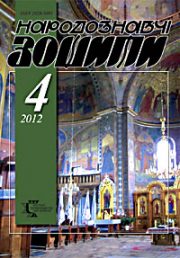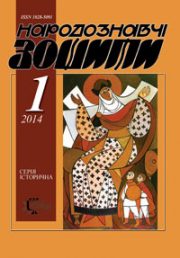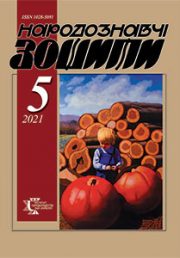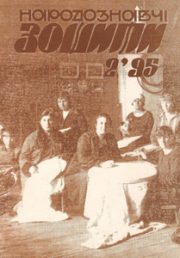The Ethnology Notebooks. 2017, 6 (138), 1433—1438
UDK 299.18+398.3+930.85
DOI https://doi.org/10.15407/nz2017.06.1433
Received 23.10.2017
ETNOCULTURAL IDENTITY OF SIMARELLA (SIMARGLA)
Kyrii Viktor Vladyslavovych, Deputy Editor-in-Chief
Kyrii Viktor Vladyslavovych, Deputy Editor-in-Chief
of the Drohobych District Newspaper “Frankovyi Krai”,
Finder of a Ph.D. degree
at the Institute of Ethnology
of the National Academy of Sciences of Ukraine.
Svobody Avenue, 15, Lviv, 79000, Ukraine.
Contacts: Tel. (032) 2970157; e-mail: ina@mail.lviv.ua
Abstract. The issue of ethnocultural identification of a deity is investigated, the idol of which was staged by Vladimir the Great alongside the idols of the main gods of the ancient Rus pantheon. The author shows a new («Varangian») version of the identification of «Semargl».
Keywords: Simargl, Simurg; Senmurv; Sim and Regl, Iranian version; the pantheon of Vladimir the Great; the Pragermanic language; Scandinavian mythology; the Vikings.
REFERENCES
Vasil’ev, M.A. (1989). Bogi Hors i Semargl vostochnoslavjanskogo jazychestva. Religii mira. Istorija i sovremennost’. Ezhegodnik,1987 (pp. 134—156). Moskva: Nauka. [in Russian]
Gal’kovskij, N.M. (1916). Bor’ba hristianstva s ostatkami jazychestva v Drevnej Rusi (Vol.1). Har’kov. [in Russian]
Gerber, H. (2006). Mify Severnoj Evropy. Moskva: Centrpoligraf. [in Russian]
Korolev, K. (2007). Skandinavskaja mifologija. Enciklopedija. Moskva: Eksmo. [in Russian]
Struve, V.V. (Ed.). (1965). Korpus bosporskih nadpisej. Moskva, Leningrad: Nauka. [in Russian]
Levickij, V.V. (2010). Etimologicheskij slovar’ germanskih jazykov (Vol 1). Vinnica: Nova kniga. [in Russian]
Tokarev, S.A. (Ed.) (1992). Mify narodov mira. Enciklopedija (Vol.2). Moskva: Sovetskaja enciklopedija. [in Russian]
Yaremenko, V.V. (Ed.). (1990). Povist’ vremianykh lit: Litopys (Za Ipats’kym spyskom). Kyiv: Radians’kyj pys’mennyk. [in Ukrainian]
Ribakov, B.A. (1987). Jazychestvo Drevnej Rusi. Moskva: Nauka. [in Russian]
Tolochko, P.P., Borovs’kyj, Ya. (1979). Yazychnyts’ke kapysche v «horodi» Volodymyra. Arkheolohiia Kyiva. Doslidzhennia i materialy (pp. 3—10). Kyiv. [in Ukrainian]
Holder, A. (1886). Saxonis Grammatici Gesta Danorum. Strassburg.
Toporov, V.N. Evrejskijj element v Kievskoj Rusi. Svjatost’ i svjatye v russkoj duhovnoj kul’ture (Vol. 1). Retrieved from https://religion.wikireading.ru/193469
Ivanov, I. Kul’t Peruna u juzhnyh slavjan. Retrieved from http://www.istmira.ru/knigi-istoriya-belarusi/11/ 11/page/8/11/ page/1/11/page/2/11/page/3/11/page/1/11/page/2/11/page/4/Kuljt-Peruna.html
Adam von Bremen. Gesta Hammaburgensis ecclesiae pontificum. Retrieved from http://www.vostlit.info/Texts/rus/adam_br/frameadam_buch4.htm
Die Cronik Thietmar von Merseburg. Retrieved from http://www.mghbibliothek.de/dokumente/b/b009173.pdf







